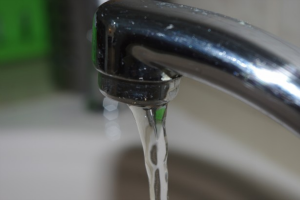 Most people expect a crisis to break out suddenly and with obviously devastating effects. In fact, when you hear words like “crisis” and “disaster,” you probably imagine quick, shocking events that leave a trail of bodies and destruction. However, it’s often the case that crises will unfold at a snail pace. And when they do, most people don’t even notice what’s happening until it’s too late.
Most people expect a crisis to break out suddenly and with obviously devastating effects. In fact, when you hear words like “crisis” and “disaster,” you probably imagine quick, shocking events that leave a trail of bodies and destruction. However, it’s often the case that crises will unfold at a snail pace. And when they do, most people don’t even notice what’s happening until it’s too late.
That certainly seems to be the case with America’s water supply, which appears to be a slow-motion train wreck unfurling before our eyes. A recent study from Michigan State University has made light of how expensive water has become in our country. The researchers who produced the paper projected the future costs of water and found that more than a third of American households may not be able to afford their water bills in just a few short years.
If water rates rise at projected amounts over the next five years, conservative projections estimate that the percentage of U.S. households who will find water bills unaffordable could triple from 11.9% to 35.6%. This is a concern due to the cascading economic impacts associated with widespread affordability issues; these issues mean that utility providers could have fewer customers over which to spread the large fixed costs of water service. Unaffordable water bills also impact customers for whom water services are affordable via higher water rates to recover the costs of services that go unpaid by lower income households.
It’s important to keep in mind that different cities may have different rules about how they treat households that can’t pay their bills. But it’s usually the case that if you can’t pay your water bill, the city will shut off your supply. Though the federal government will often help pay water bills for impoverished families, many households still slip through the cracks. So we’re looking at the possibility of tens of thousands of Americans (and perhaps more than that) not having access to tap water in the very near future.
As for what’s going to cause water prices to spike, the researchers cited climate change and our crumbling infrastructure. However, the cost of repairing our water infrastructure is going to have a far more devastating effect on our utility bills over the next generation.
A variety of pressures ranging from climate change, to sanitation and water quality, to infrastructure upgrades, are placing increasing strain on water prices[8]. Estimates of the cost to replace aging infrastructure in the United States alone project over $1 trillion dollars are needed in the next 25 years to replace systems built circa World War II, which could triple the cost of household water bills
Another issue is the fact that many metropolitan areas are being hollowed out, as people pack their bags and move to the suburbs. This trend isn’t happening across the board, but in the cities where it is happening, it’s leave the remaining residents with increasingly expensive water bills.
A hidden pressure on urban water systems is slow or even declining population growth, which reduces the customer base over which the high fixed costs of water services are distributed, and places increasing pressure on household water bills. This is the case in Detroit where a declining population has left fewer customers to pay for water. Another critical issue is the suburbanization of people, which also leaves providers in core central city areas with fewer customers to pay for water services. This means that for cities across the United States, shrinking populations in particular metropolitan areas and in downtown areas, combined with other pressures on urban water systems, present a perilous future for water utilities and their customers.
You may be wondering how this is possible? If fewer people are consuming water from a given source, then there’s less demand for water in that area. Sure, the water companies aren’t receiving as much money, but they also don’t have to spend as much to deliver water, right?
Well, the infrastructure still needs to be revamped and repaired, and now they have fewer customers to pay for it. And perhaps more importantly, many of the cities that are facing population declines, also owe a ton of money to retired workers who are now collecting pensions. It’s likely that many of these water utility companies are publicly run, and face massive pension liabilities. Those costs will likely be placed on the remaining residents in these cities (the research paper makes no mention of this).
In any case, this isn’t just happening in large cities. It’s happening across the country. We have to face a startling new reality. Here in the United States; one of the wealthiest and most developed nations in the world, there may soon be tens of thousands of households that don’t have access to clean tap water. This state of affairs won’t be caused by a war or natural disasters. In this case, it seems that financial mismanagement is the real disaster. And how so many of these people are going to find clean drinking water once their taps are shut off, is an unsettling mystery.
Additional Resources:
Emergency Water Storage Ideas for Every Type of Disaster
How to Find and Purify Water Sources You Never Considered
Simple Ways to Purify Drinking Water in Emergencies
Survival Skills: How to Find Water In the Wild
Smart Survival: This is How You Find Water When There Is None To Be Found

my malwarebytes identified this as a malicious web site. Don’t click on anything on this site as you may pick up a virus including ransomeware……………………………………….!!!!